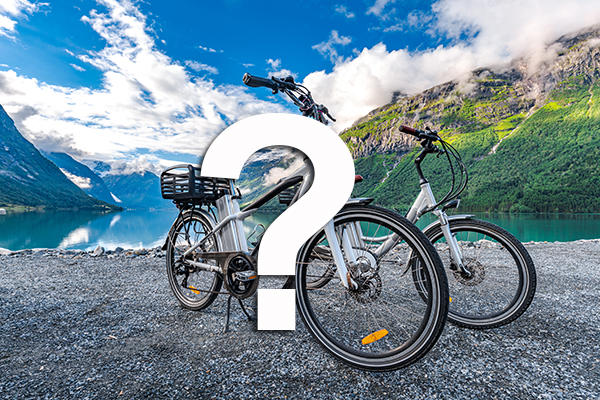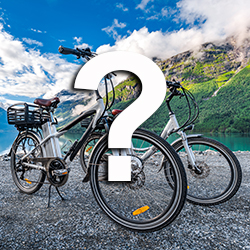
Considering Buying and Electric Bike – Your Questions Answered
If you are planning on buying and ebike you are probably changing up from a traditional cycle. Whilst both comprise a frame, two wheels and pedals there is a lot mor to an electric bike or ebike as they are increasingly referred to. So let’s address some of the Frequently Asked Questions in relation to buying an eBikes.
Do I have to pedal an eBike?
Electric Bikes vary geographically. in Europe ebikes generally have 2 functions – Normal Cycling mode with no power and Pedal Assist which means that whilst you need to pedal the motor takes the strain. In North America however, you are permitted an additional Throttle Function which permits the rider to sit back and not pedal at all. Of course there are restriction on that functions which are explained below.
What is Pedal Assist on an eBike?
Pedal Assist, also referred to as pedelec, is a mode that provides power only when you are pedaling. If you are used to riding a traditional bicycle, the pedal assist mode has a more intuitive feel compared to the throttle mode. The pedal assist mode is also nice because you can focus purely on your pedaling and you don’t have to hold the throttle in a certain position.
Since you have to pedal, the pedal assist mode will generally give you more range when compared to the throttle mode anf of course provides exercise too.
What is Throttle Mode on an Electric Bike?
Not all eBikes have throttle mode and indeed in some countries, mainly UK & Europe it is not permitted. The throttle mode is similar to how a motorcycle or scooter operates. When the throttle is engaged the motor provides power and propels you and the bike forward. A throttle allows you to pedal or just kick back and enjoy the ride. Most throttles can be fine tuned like a volume dial between low and full power. Of course extensive use of throttle mode exhausts the battery much quicker.
Here are a few of the different types of throttles found on electric bikes:
- Half grip twist throttle – the throttle is engaged by twisting the throttle; similar to a motorcycle or scooter. This is the most common type of e-bike throttle.
- Thumb throttle – the throttle is engaged by pushing the throttle “paddle” forward with your thumb.
- Push button throttle – this particular throttle is simply an on/off switch and there is no way to adjust between low and full power.
Are there Speed Restrictions on Electric Bikes?
Of course riders of eBikes are unlicensed so the speed that you can travel at using the motor is limited by law.
USA –20mph is the legal limit at which the motor can assist the rider on a e-bike.
Canada – a maximum speed capability of 32 km/hr
UK and Europe – cut off’ speed of 15.5 mph/25kph
What are Class 1, 2 and 3 in relation to e-Bikes?
Not all US States claasify Electric Bikes and there is confusion across the country. In California things are quite well defined
Class 1 electric bicycle:
- Low-speed
- Pedal-assisted
- 9 pedal assist levels
- Maximum speed 20 miles per hour
Class 2 electric bicycle:
- Throttle-assisted
- Motor for propelling the bicycle
- Maximum speed 20 miles per hour
Class 3 electric bicycle:
- Speed-pedal-assisted
- Maximum Speed 28 miles per hour
- The helmet is necessary for this level riding
- The age of the rider must be 17 and under. Class 3 e-bikes are illegal for 16 and underage riders.
What type of drive should I choose for my e-bike?
Presently there are two types of motors for e-bikes. – the wheel motor, also known as the hub motor;and the the centre drive, which is also called the mid drive. Some have the opinion that the centre drive is of a better quality, but few can justify this statement The considered opinion is that neither type of e-bike motor is better than the other but that they have different advantages depending on what you require
1) Wheel motor
An e-bike with “Wheel Drive” is by far the most common on the market and it certainly has many merits and importantly, a lower price than the centre drive. This motor gives you more flexibility when selecting the pedaling power since it drives the wheel, instead of the crank which allows the wheels to turn fast, even if the pedals are not turning.
2) Center Drive/Mid Drive System
An e-bike with a “Center Drive” motors will surprise you with a comfortable dose of performance and a short battery assist reaction time. Important too is that the centralised motor placement in the crank ensures better weight distribution on the e-bike. Reliability and efficiency are built in and they are typically more powerful than the hub varieties.
Very often the disadvantage of an e-bike with Center Drive is a higher purchase price. However, the higher price will doubtless be repaid in a longer engine lifetime; plus the more expensive electric bikes usually have better mechanical equipment.
What Cycling Range can I get from an e-Bike?
The range that can expect to achieve from you e-bike is dependant upon so many factors
- Use of Power Functions
- Weight of Rider.
- Wind
- Terrain
- Capacity of Battery
With Folding Electric Bikes which are designed to be compact and very lightweight will get a lesser range. With their weight saving smaller batteries they are intended for a journey across town or similar and not an epic journey. With the Top Selling Electric Bike the Swagtron EB-5 Electric Folding Bike you will get around 15.5 miles if using Throttle Mode and obviously more if you use pedal assist combined with pure pedal power. Another Top Selling e-Bike, the ECOTRIC 20″ Fat Tire Folding Electric Bike achieves up too 23 miles if using Throttle Mode.
With Mountain Bike styled Electric Bikes almost always the battery is larger and positioned on the frame rather than in the frame as commonly the case with folding bikes. This large battery has a high capacity and so delivers more miles. Ancheer’s range of Electric Mountain Bikes and the Ancheer 27″ Blue Spark Electric Moutain Bike with its larger capacity battery can achieve up to 25miles in throttle mode and 43 miles in pedal assist mode

